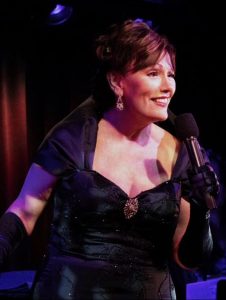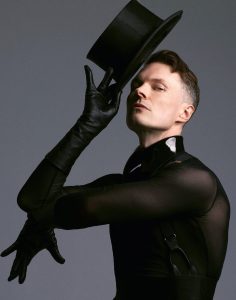Paying Tribute: Various Approaches One Can Take When Celebrating the Work of an Artist
Performers paying tribute to a singing icon or big name writing-composing team usually work within a clearly defined genre. They belt or croon the tunes identified with the anointed artist(s) in their best voices.
But sometimes other ingredients are added to the mix—from unexpected interpretations to political implications to using the songs as a vehicle for self-exploration. The aesthetic and cultural revolution that has informed other art forms is now rearing its head in the world of musical tribute.
Kim David Smith, evoking a genial yet sly non-binary gay person, is at once Marlene Dietrich’s heir and channeler (Mostly Marlene); moving backwards and forwards in time, Meg Flather celebrates the contemporary politics and sensibilities of Richard Rodgers and Oscar Hammerstein (Rodgers & Hammerstein); and Mark Nadler creates a musical fantasy, Harts’ Desire, awash in homosexual and bisexual characters, that marries the dialogue of Moss Hart and the lyrics of Lorenz Hart, both of whom were closeted. “It is the show they might have written if they had been living in a time when being open about one’s sexuality was not taboo,” he says. “But their sexuality was the least of what drew me to them. It was their dazzling wit.”
Slightly more traditional, we have They Call Me Cuban Pete: The Music and Genius of Desi Arnaz, its author and interpreter Danny Bolero merging with his theatricalized second self, in a part real/part imagined creation; while Josephine Sanges’s The Funny Girl in Me is both a Fanny Brice panegyric and personal narrative
These five performances, while anomalous given the high level of scholarship, sophistication, and nuance, suggest a new approach to tributes, and the not-readily-definable genre has the opportunity to flourish in cabaret thanks to venue size, sensibility, and economics.

“Generally, a larger net has been cast in paying tribute,” says Sidney Myer, veteran cabaret performer and booking agent at Don’t Tell Mama. “Many other composers and singers are receiving tributes, not just Gershwin or Porter. Now we have tributes to Jonathan Larson, Jason Robert Brown, Jim Croce, and Todd Rundgren. Impersonators, including drag performances, have grown more serious— even those that still have campy elements. A dramatic first-person autobiographical show about a star is relatively rare because the actor needs to resemble the person he’s embodying. Still, we are seeing them more frequently in cabaret.”
Nonetheless, some trends are constant. Good storytelling skills and musical chops continue to head the list, perhaps more so than ever. “Performers want the music to land,” adds Myer.
Pulling together these musical toasts is a complicated, multi-tiered process from defining their structure and narrative arc to choosing, placing, and interpreting the songs.
That’s of course true for the traditional tribute as well where the top priority is the musical match. If you’re choosing an icon to celebrate, the tunes identified with that artist need to be a natural fit and at the same time shed a flattering light on you. Otherwise, why bother?
Even if biographical or autobiographical or indeed broader cultural snippets are interwoven into the performance in the end it’s the singer’s presence, voice, and interpretation that has to carry the evening.
With a Song in Her Heart—The Traditional Tribute and the Paranormal Bond
A perfect case in point is Valerie Lemon’s The Jane Froman Songbook—With a Song in My Heart. She commands the stage, is elegantly clad, and sings in an exquisite soprano voice.
“Emulating Froman is not my ambition,” she stresses. “My voice is much higher than hers, although I try to capture her phrasing, the way she holds her notes, and her energy. With the exception of the last song, ‘Get Happy,’ where I embody her physicality—her head movements, her arm movements—I’m not attempting to be her.”

Still, there’s an eerie overlap. Lemon, known for sporting beautiful gowns onstage, points out that Froman always performed in long evening dresses to camouflage a leg brace she was forced to wear because of a horrific airplane accident she survived as a younger woman. Lemon’s classy costuming, complete with long evening gloves, brings to mind the high-end nightclubs of the 1940s and ’50s. It was Froman’s world, and Lemon feels right at home.
Lemon insists she did not choose Froman, but rather Froman chose her; and only after she read up on the star, listened to her records, and interviewed those who knew her, did Lemon discover a special musical kinship with Froman’s songs and an unexpected admiration for the artist’s personal narrative.
Though hardly a household name today, Jane Froman (1907-1980) was a major player in radio’s heyday. She later became a Ziegfeld girl before moving on to nightclubs, Broadway, TV, films, and recordings. Her core repertoire included Gershwin, Arlen, Rodgers, Berlin, and other American Songbook heavy hitters.
She frequently performed on USO tours and, tragically in 1943, her plane en route to one of these shows, crashed. She was among the few who survived, sustaining serious injuries leading to 39 operations.
Doctors wanted to amputate a leg that had become infected, but she refused. And eight months after a series of surgeries she was performing for the troops in a wheelchair. From the outset she endured a hard scrabble existence, yet she prevailed. Her life was celebrated in the 1952 biopic, With a Song in My Heart, starring Susan Hayward.

“I had seen the movie with Hayward, though Froman was not in my consciousness at all,” Lemon emphasizes. “I certainly had no idea what she looked like until I had a dream in which she appeared and introduced herself. When I woke up I Googled her and was shocked to find that the woman in my dream looked exactly like the Google photo. I said to myself, ‘I’m supposed to do a show about Jane.’”
And that’s when she launched her research, one contact leading her to the next—from Froman’s website editor, to her biographer, to her fan club, to various colleagues, etc. It took Lemon a couple of years to fashion the tribute, first creating the story and then selecting the songs (“Blue Moon,” “It’s Most Unusual Day,” “Begin the Beguine”) to flesh out the narrative. Co-written with and helmed by Eric Michael Gillett, Lemon has molded a nostalgic musical evening that celebrates Froman’s tenacity, faith, and courage—values that never go out of style.
“If I can do it, you can do it!” Through Lemon, Froman motivates us from beyond the grave.
A Woman Ahead of Her Time
Josephine Sanges’s The Funny Girl in Me, a layered and timely tribute to Fanny Brice, almost didn’t come off precisely because of its topicality. It was ready to go way before the current Broadway revival of Funny Girl, but Sanges was afraid some cabaretgoers might view the tribute as opportunism on her part.

“I don’t talk about the current revival, and it is the elephant in the room,” she says. “This is the scariest show I’ve ever done. I was afraid people would say, ‘How dare she?’ I’m not even Jewish. But I have received no flak at all.”
In fact, the reviews and public response have been glowing, and Sanges now views the confluence of events, including the Funny Girl revival and the scuttlebutt that surrounded it, as proof positive that there are just six degrees of separation between herself and Brice and that she was meant to do the show.
Sanges made her debut 27 years ago as the title character in Funny Girl. It was a semi-professional production in community theatre, and a turning point for Sanges. That show exposed her to the exhilaration of the American Songbook and recast her professional trajectory. Indeed, she went on to win awards for her tributes to American Songbook stars, and as she approached the 25th anniversary of her debut, she decided to pay homage to the artist who launched her career. It’s an autobiographical/tribute hybrid.
There were hurdles from the outset, not least the fact that Fanny Brice will always be identified with Barbra Streisand. Many of the songs are so deeply embedded in the Streisand canon, audiences expect to hear those songs, and sung à la Streisand, Sanges admits. “It’s inevitable in a Fanny Brice tribute,” she says.
“I make a reference to Streisand in one number—how she landed the Funny Girl gig and then got an Oscar. I sing “How Lucky Can You Get.” I am not imitating Streisand’s voice, but I am singing it through her perspective.”
Collaborating with musical director John M. Cook and director Jeff Harnar, Sanges created a delightful and thought-provoking show that centers on her own experiences in Funny Girl, interwoven with biographical snippets about Brice—from her early years as Fania Borach, to her many decades as vaudevillian star, aka Fanny Brice, to Baby Snooks, an iconic radio character Brice played in the 1940s.
For the most part, Sanges sings in her own voice, though occasionally donning a Brice vocal style when she is playing Brice. It’s a daunting challenge since there’s not much available footage featuring Brice. Sanges takes an informed leap of imagination.
But then saluting Brice is far more important than impersonating her. Sanges wants the audience to first recognize Brice as a female entertainer, the highest paid of her era, one who defied tradition, and triumphed despite the many obstacles. A woman well ahead of her time, arguably a feminist, she is Sanges’s mentor and motivator.
“I admire her gumption,” says Sanges. “I’m just the opposite. I wish I had been more like her. Not many audiences know that she was a real and fascinating person. In 1925 she wrote an article for the Saturday Evening Post talking about the importance of interacting with your audiences, and the differences in audiences in New York vs. Chicago vs. the Catskills. She was born more than a century ago, yet her life experiences are not all that removed from our own. She speaks to a contemporary sensibility and I’d like audiences to leave the theatre wanting to know more about her.”
Comic, Showman, Mogul
 Actor Danny Bolero (In the Heights, Plaza Suite, Joseph and the Amazing Technicolor Dreamcoat) feels similarly about his onstage alter-ego in They Call Me Cuban Pete: The Music and Genius of Desi Arnaz. It’s a one-man autobiographical musical play, straddling the worlds of cabaret and theatre, told in the first person by Arnaz, best known as Ricky Ricardo, Lucy’s comically beleaguered husband in I Love Lucy. But he was also a singer, bandleader, and television mogul.
Actor Danny Bolero (In the Heights, Plaza Suite, Joseph and the Amazing Technicolor Dreamcoat) feels similarly about his onstage alter-ego in They Call Me Cuban Pete: The Music and Genius of Desi Arnaz. It’s a one-man autobiographical musical play, straddling the worlds of cabaret and theatre, told in the first person by Arnaz, best known as Ricky Ricardo, Lucy’s comically beleaguered husband in I Love Lucy. But he was also a singer, bandleader, and television mogul.
Ethnic identification, pride, and plain old nostalgia, initially drew Bolero to Arnaz. I Love Lucy was Bolero’s go-to comfort TV when family dysfunction became unbearable. Those reruns are still his solace and escape at rugged moments. More important, Arnaz was the only actor on TV that even remotely resembled Mexican-American Bolero. From an early age, Bolero knew he wanted to perform and, as an aspiring actor, Desi’s presence was bedrock significant.
That connection only grew as he learned more about Arnaz. “When I read his biography I was surprised at how blatant the racism was,” says Bolero who experienced his own share of racism in theatre. “In the beginning I couldn’t get an agent. They said, ‘you’re not Black, you’re not white, and you don’t dance.”

For Arnaz, a Cuban immigrant in the 1940s and ‘50s, it was that much worse. It took close to a decade for I Love Lucy to hit the airwaves thanks to Arnaz’s Latino heritage and marked Hispanic accent. The powers that be didn’t think mainstream audiences would tolerate him as Lucy’s husband, and they were indifferent to the fact (or ignorant of it) that Arnaz had a successful musical career way before Lucy.
The sitcom was not only a mega-success, it was ground-breaking due in large part to Arnaz’s foresight. It was filmed in L.A., employed multiple 35mm cameras on set, and helped establish the concept of residuals and syndication. Ball and Arnaz maintained ownership of the production. That, too, was unprecedented.
“These facts are not widely known,” says Bolero. “What is known is that Arnaz was a philanderer and alcoholic.” They Call Me Cuban Pete, which ends before the dissolution of his marriage to Ball, is meant to serve as an antidote, entertaining, but corrective too.
Cuban Pete is a memory play that opens in 1986, the year Arnaz died and his ghost (at least one assumes it’s his ghost) is revisiting a club about to be shuttered where he once performed. The rest is flashback recalled through the distorting prism of recollection.
Bolero captures Desi as a consummate self-effacing comic, a blustering, hot-tempered fictional Ricky Ricardo, a tuxedo-clad, smooth and sexy showman, as well as the introspective Cuban refugee forced to flee his homeland in 1933 and face the many impediments as a Latino immigrant in America. Bolero’s facial expressions (e.g., flashy signature smile) down to his posture, gait, and gesture, are uncanny. In song and speech, Arnaz is spot on, though Bolero admits mastering a Cuban accent—which is not the same as Mexican-flavored English—was a bit of a challenge.
But it was most important for Bolero to embody Desi’s energy and his lack of fear. “He was not afraid to take risks,” Bolero says. “He often said his career was not based on planning, but rather allowing events to take him wherever. That was a repeated theme in his life.”
Bolero is still working on the piece, hoping to transfer it to a small theatre. But so far he is satisfied with its progress and pleasantly surprised at audience response.
“A lot of people are very interested in Desi.”
Darkness and Light

Meg Flather, a highly-polished and much awarded cabaret singer (two Bistro and four MAC awards) opens her Rodgers & Hammerstein 2021+ (the “2021+” was added to the show title at the start of 2022) in tribute singing “A Cockeyed Optimist” (South Pacific), establishing her pervasive optimism despite what’s to come. Many of her songs, written in the 1940s and ‘50s, are darkly unsettling and continue to resonate. Consider: “You’ve Got to Be Carefully Taught,” a musical ode to teaching children bigotry.
“Rodgers and Hammerstein are profoundly contemporary,” says Flather, likening the show to a “musical thesis” about the duo who, contrary to their hokey Americana ethos, were cutting edge. (The legendary Agnes De Mille ballet in Oklahoma! was only one example.)
“They created strong female characters, vulnerable male characters, tackled taboo subjects, told true war stories, introduced audiences to international cultures, and questioned the American Dream,” Flather says. ‘Flower Drum Song’ featured the first all-Asian cast on Broadway.”
Flather’s connection to the material is personal. Her late parents, both social activists and progressives, introduced her to Rodgers and Hammerstein. During her mother’s final decade, as she declined from Alzheimer’s disease, they maintained and enhanced a lifelong bond by playing the old R&H albums. In the wake of her mother’s death and simultaneously grieving our political scene, she found herself once again drawn to Oklahoma!, Carousel, and South Pacific, among others. They spoke to the moment, yet offered hope.
Combing through the R&H repertoire she was struck by how many pieces revealed her own narrative as an American woman in 2020 (when she first wrote the tribute). For example, in her strong rendition of “I’m Just a Girl Who Can’t Say No,” she plays a mature woman enjoying her sexuality as opposed to Oklahoma!’s Annie Ado, usually spun as a goofball nymphet. But even within those parameters, Annie was well ahead of her time, Flather points out.
The whole show, interspersed with background information about Rodgers and Hammerstein, is structured around thematic motifs (e.g., women’s roles, men’s roles). Throughout, Flather sings in her own voice and interprets the songs through a current political lens.

“The Hills are Alive” becomes a celebration of nature and a plea for addressing climate change. Similarly, “A Puzzlement” illustrates the hesitancy international leaders have in working with heads of state who come from far-flung cultures. It’s a song written for a male actor, and is most identified with Yul Brynner. Yet Flather unabashedly makes it her own. Similarly, “People Will Say We’re in Love,” an Oklahoma! favorite, is morphed into a song about forbidden love among, she explains, possibly gay or trans people.
“My first challenge was to trust the thesis,” she says. “My second challenge was singing in a legit voice, no belting, no pushing. That requires discipline. My third challenge was remaining mindful of how vocally challenging the songs are and how easily I could hurt myself.”
On the contrary, ending on an affirmative note (remember, she’s a cockeyed optimist), she’s discovered that the journey has been very healing for her. She’s hopeful the audiences feel the same.
“What I most love to hear from my audience is that they’ve had an evening with themselves,” she says. “If I’m doing my job, they’re on a personal journey. The greatest compliment I can get from someone who has seen the show is ‘I’ll be thinking about this for a long time.’”
Pastiche as a Valentine
Asked what he hopes audiences think and feel as they leave his one-man show, Harts’ Desire, Mark Nadler doesn’t miss a beat. “I hope they think and feel.”

It’s a line that could have come right out of his one-man eight-character madcap romp that illustrates his chops as an actor, piano player, singer and yes, tap dancer too. His high-octane performance is, to use an overused term, a “tour de force.” But at its core it’s a valentine to the two Harts, Larry and Moss, each of whom, despite wild success, was in some ways marginalized, the walking wounded. “Larry Hart was a deeply disturbed soul,” says Nadler. “His song says it all, ‘Falling in love with love is falling in love with make believe.’”
Employing their words, wit, and sensibility, Nadler shapes a work that is totally his and totally theirs; if only they had time traveled to the present to live freely in their own skins and write the forbidden musical. It’s a Mark Nadler amalgam of affection and speculation in equal measure.
It’s pure pastiche inspired by Moss Hart’s Light up the Sky—a zany show-biz romp set in the early 1940s as actors, writers, and producers run in and out of a Boston hotel room as they prepare for their preview performance and grow increasingly demented as they do.
Characters lifted from other Hart plays, brimming in high jinks antics, also surface. But in all cases, the dialogue is one hundred percent Moss Hart. The storyline has been tweaked a bit to accommodate the songs and the updated vision.
The songs’ lyrics, culled from various Larry Hart musicals, are almost entirely Larry’s, although in one instance Nadler rearranged the order of the verses, and in another, “Good Bad Woman,” a song originally written in the first person, was changed to the third person.
Nadler writes in the program notes, “Because I had only a scratched-out melody by Richard Rodgers, I had to fit the lyrics to Rodgers’ melody as best I could and even compose the accompaniment. So given that no one has ever heard this song before, ever, I thought it was okay to take this liberty.”
But context is everything. “The Heart is Quicker than the Eye,” takes on a whole other meaning given the gay themes here. It’s even clearer with “This Can’t Be Love,” sung by two male characters.
Among Nadler’s many challenges was “making sure the songs were integrated into the story and advanced the plot,” he says. “It had to flow. Finding the songs was easy. Finding the dialogue to support the songs was more difficult.”
The two-act show starts with Nadler seated at the piano explaining that we, the audience, are backers at a 1943 audition, and true to the tradition, he will sing all of the songs and play each of the eight roles. With a slight change of expression or vocal cadence, he introduces each, including the high maintenance diva Althea Royce, the low-life producer Sidney Black, the innocent ghost writer Bert Jefferson, the sophisticated Brit playwright Owen Turner, the highfalutin theatre director Carlton Fitzgerald, and (among others), a newbie playwright and former truck driver, Peter Sloane, who is the object of everyone’s desire. Act I begins.
For the next two hours Nadler joyously, seamlessly, and in rapid-fire succession, moves from one caricature to the next, each one clearly and consistently delineated. Likewise, his songs, from the brassy numbers to the tear-jerker tunes, are distinct from each other and delivered with panache. The audience eats it up. One can only imagine that the two Harts would be thrilled.
The Elusive World of Androgyny, Ambiguity, and Shadow

It’s harder to discern what Marlene Dietrich’s response might be to Kim David Smith’s tribute to her in Mostly Marlene short of a sultry look that could mean virtually anything.
It’s a performance that almost defies easy interpretation, and perhaps that’s the ultimate homage given the legendary figure frequently seen through a Victor/Victoria lens, “A woman playing a man playing a woman.”
“I find the Victor/Victoria idea a bit of a snooze,” says the Australian born Smith, who suggests that his tribute—and he doesn’t much care for the “tribute” concept either—is not unlike a séance that conjures up the elusive spirit of a great star whose “gender presentation is playful,” he says.
“She had male lovers, female lovers, wore a tux, top hat, and leather gloves. She was feline and feminine, and also so irrefutably masculine and grounded. In 1932 she disembarked from a ship wearing pants. Everyone was shocked.”
While hints of camp and drag show are lurking throughout, Mostly Marlene is neither. Existing in a kind of smoky, alcohol-fueled netherworld (intended to evoke a Weimar nightspot), the glitz, glam, and decadence are intrinsically present but never leaned on.
Sporting Dietrich’s aforementioned costume plus eyelid glitter (a wink to the contemporary), an androgynous Smith-Dietrich amalgam is at once easy, smooth, and predatory. Slithering through the audience, or seductively beckoning no one in particular from onstage, or remaining motionless and silent, Smith’s creation is spectral. Especially so as he sings her signature songs (most notably “Falling in Love Again”) and traces her life’s trajectory—from Berlin to Hollywood and back again, from health and disease, to survival. Throughout, the past and present are interwoven, including topical references and sly musical nods to current queer mega icons like Minogue, Madonna, and Minnelli.
Dietrich’s politics was a centerpiece, says Smith. “During the Third Reich she performed for the Allied soldiers on the frontlines and she was openly critical about Germany, her homeland. And although she was a great star, she was also a hausfrau. She’d scrub floors and clean toilets at the Hollywood Canteen.”
Smith resurrects her (sort of) to reveal her magic as a sentient human being, a brilliant and complicated artist, and, equally important, her continuing thread to contemporary divas (specifically their larger-than-life personas and underlying vulnerability). Also, heading the list of her virtues, she has given Smith the opportunity to “sing songs to express those feelings that I myself can’t put into words,” he says, adding slyly. “I want audiences to be madly in love with me.”
###
About the Author
Simi Horwitz is an award-winning feature writer/film reviewer who has been honored by The Newswomen’s Club of New York, The Los Angeles Press Club, The Society for Feature Journalism, the American Jewish Press Association, and the New York Press Club (among others). She received an Honorable Mention from Folio: Eddie and Ozzie Awards for her two drag stories (May 22, 2020, August 4, 2020) published here on BistroAwards.com. More recently, she was the recipient of the 2023 New York Press Club Award and won three 2023 L.A. Press Club Awards., including first prize for film criticism (for reviews published in the Forward). The publications that have printed her work include The New York Times, The Washington Post, The Hollywood Reporter, Film Journal International, and American Theatre. She was an on-staff feature writer at Backstage for fifteen years (1997-2012).




